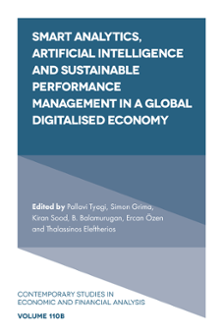
Index
ISBN: 978-1-83753-417-3, eISBN: 978-1-83753-416-6
ISSN: 1569-3759
Publication date: 29 May 2023
Citation
(2023), "Index", Tyagi, P., Grima, S., Sood, K., Balamurugan, B., Özen, E. and Eleftherios, T. (Ed.) Smart Analytics, Artificial Intelligence and Sustainable Performance Management in a Global Digitalised Economy (Contemporary Studies in Economic and Financial Analysis, Vol. 110B), Emerald Publishing Limited, Leeds, pp. 265-276. https://doi.org/10.1108/S1569-37592023000110B018
Publisher
:Emerald Publishing Limited
Copyright © 2023 Pallavi Tyagi, Simon Grima, Kiran Sood, B. Balamurugan, Ercan Özen, and Thalassinos Eleftherios
INDEX
- Prelims
- Chapter 1: COVID 19 and Financial Performance of Banks in India: Impact and Implications
- Chapter 2: Importance of Least Cybersecurity Controls for Small and Medium Enterprises (SMEs) for Better Global Digitalised Economy
- Chapter 3: Money Laundering: A Bibliometric Review of Three Decades from 1990 to 2021
- Chapter 4: Socially Responsible Investments – A Quick Fix for Financial Crimes
- Chapter 5: Technology Governance: A New and Effective Way of Governance and Policy-making for the Economies All Over the World
- Chapter 6: User Sentiment Analysis of Cashkumar Peer-to-Peer (P2P) Lending Platform: Based on Google Reviews
- Chapter 7: An Assessment of Money Laundering and Terrorism Financing on the Indian Economy
- Chapter 8: Mapping the Literature on Implementation of Blockchain in Agriculture: A Systematic Review
- Chapter 9: Earnings Management for Sustainability: The Surplus Income Model of Sustainable Development
- Chapter 10: The COVID-19 Global Debt Crisis: How to Avoid It
- Chapter 11: Mapping the Field. A Text Analysis of Money Laundering Research Publications
- Chapter 12: Redesigning the eNaira Central Bank Digital Currency (CBDC) for Payments and Macroeconomic Effectiveness
- Chapter 13: Green Banking – The Path Leading to Sustainable Economic Growth
- Chapter 14: Digitisation and Artificial Intelligence in Retailing Sector – Key Drivers
- Chapter 15: A Study on Twitter Sentiment Analysis in TOKYO 2020 OLYMPIC
- Chapter 16: Smart Analytics and AI for Managing Modern Performance Management Systems
- Index